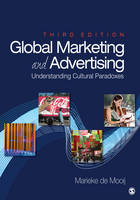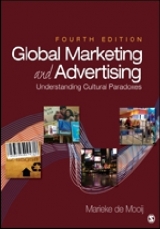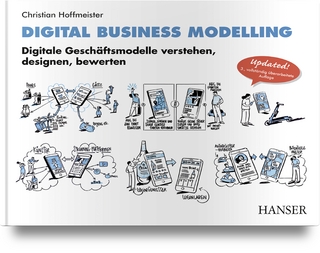
Global Marketing and Advertising
SAGE Publications Inc (Verlag)
978-1-4129-7041-9 (ISBN)
- Titel erscheint in neuer Auflage
- Artikel merken
Packed with cultural, company, and country examples that help explain the paradoxes international marketers are likely to encounter, Global Marketing and Advertising, Third Edition, offers a mix of theory and practical applications as it covers globalization, global branding strategies, classification models of culture, and the consequences of culture for all aspects of marketing communications.
In this Third Edition, author Marieke de Mooij includes new topics and updated information and findings from recent studies and helps readers apply global marketing concepts to the management of global branding and marketing communications.
New and Continuing Features:
- Includes new topics, including global public relations, culture and the media, and culture and the Internet, along with more extensive coverage of consumer behaviour
- Helps companies define cross-cultural segments to better target consumers across cultures
- Shows how culture affects strategic issues, such as the company′s mission statement, brand positioning strategy, and marketing communications strategy
- Includes both recent and classic advertising examples from various parts of the world
- Demonstrates the centrality of value paradoxes to cross cultural marketing communications
- Uses the Hofstede model to help readers see how their understanding of cultural relationships in one country/region can be extended to other countries/regions
- Instructor Resources on CD, including discussion questions, PowerPoint slides, illustrations from the book, sample test questions, and video clips are available to lecturers
Marieke de Mooij, Ph.D. (Netherlands), is a consultant in cross-cultural communications, as well as a retired profesora associada of international advertising at the University of Navarra in Spain and visiting professor at several universities across the world. She is the author of several academic publications on the influence of culture on marketing and advertising. She has also authored books on culture and consumer behavior as well as culture and communication theory worldwide.
Foreword by Geert Hofstede
Preface
Summary of the Book
Chapter 1: The Paradoxes In Global Marketing Communications
The value paradox
The global-local paradox
The technology paradox
The media paradox
Paradoxes in global marketing theory
Local markets are people, global markets are products
Focus on a unique individual
Globalization
Convergence and divergence of consumer behavior
The global-local dilemma in global marketing
Global communities
Global or local? The standardization-adaptation debate
Review of a 50 year debate
The variables that influence the standardization-adaptation decision
Effect on performance
Chapter 2: Global Branding
Global branding
Branding
The brand concept and branding models
Brand equity
Brand architecture
The global brand
Perception of global brands by consumers
Global brand strategies
The global company’s brand portfolio
Global brand communications
The importance of culture for global communications
The brand as an association nework
Chapter 3: Values and Culture
The value concept
Values are enduring
The value paradox: The desirable and the Desired
Culture defined
Cultural universals
Selective perception
Stereotyping
Manifestations of culture
Signs, symbols and body language
Imagery and music
Thinking patterns and intellectual styles
Language
Comparing cultures
Comparing nations
Chapter 4: Dimensions of Culture
Classifying cultures
High- and low-context cultures
Dimensions of time
Closure
Time orientation towards the past, present or future
Time is linear or circular
Monochronic and polychronic time
Cause and effect
Relationship of man with nature
Hofstede′s five dimensions of national culture
Power distance (PDI)
Individualism/collectivism (IDV)
Masculinity/femininity (MAS)
Uncertainty avoidance (UAI)
Long-term orientation (LTO)
Configurations of dimensions
The USA
The Netherlands
Japan
Chapter 5: Culture and Consumer Behavior
Consumer behavior
Consumer attributes
The concept of self
Personality
Personality traits
Identity and image
Personality and identity in marketing
Attitude
Lifestyle
Social processes
Needs
Motivation
Buying motives
Emotion
Emotions in advertising
Group processes
Opinion leaders
Mental processes
Language, perception and memory
Locus of control
Information processing
Decision making
Consumer decision making styles
Business decision making
Consumer behavior domains
Product acquisition, ownership and usage
Complaining behavior
Brand loyalty
Diffusion of innovations
Chapter 6: Researching and Applying Cultural Values
Value research
Value priorities vary
Mixing terminal and instrumental values
Value shift
Culture-specific values
Belgian values
Dutch values
Indian values
Japanese values
Important values don’t translate
Measuring cultural values
Measuring the desired versus the desirable
Individual- and culture-level
Equivalence of survey data
Sample equivalence
Linguistic and conceptual equivalence
Metric equivalence
Comparing dimensional models
Applying the Hofstede dimensions to marketing and advertising
Understanding manifestations of culture
Comparing groups of cultures
Cause-effect
Commercial value and lifestyle research
Value structure maps
Chapter 7: Culture and Communication
Communication and culture
Interpersonal communication styles
Interpersonal communication and the electronic media
Mass communication styles
Advertising styles
The purpose of marketing communication
Informational versus emotional
Measuring advertising: Persuasion of likeability
How advertising works
The hierarchy of effects
High- and low involvement
Visuals in advertising
Appreciation of advertising in general
Public relations
Web site design
Design: Logo, product, package and retail design
Chapter 8: Culture and the Media
An ever changing media landscape
Media usage across cultures
Television
IPTV
Radio
Press media
The mobile phone
The world-wide web
E-commerce
Search marketing
The social and entertainment roles of the internet
Social networks
The blog
Internet advertising
Ad format acceptability and effectiveness
Viral marketing
Online video advertising
Mobile marketing and advertising
Will the worldwide web facilitate standardization?
The organization of international media planning
Chapter 9: Culture and Advertising Appeals
Appeals in advertising
The value paradox as an effective advertising instrument
Equality paradox
Dependence and freedom paradoxes
Success paradoxes
The innovation and global paradox
Examples of appeals by dimension
Power distance
Individualism/Collectivism
Masculinity/Femininity
Uncertainty avoidance
Long-term orientation
Consequences for advertising concepts
Do great ideas travel?
The country-of-origin appeal
Why humor doesn′t travel
Chapter 10: Executional Style and Culture
Classifications of advertising forms
Seven basic advertising forms worldwide
Announcement
Association transfer
Lesson
Drama
Entertainment
Imagination
Special effects
Relationship basic form, culture and product category
Chapter 11: From Value Paradox to Strategy
A company’s mission and vision
Corporate identity
Product/market development across cultures
Branding and culture
Brand positioning across cultures
External aspects: Product usage and brand image
Product usage
Brand image
Internal aspects: Brand identity & personality and brand values
Brand identity and personality
Brand values
Brand positioning matrix
Marketing communication strategy
Fully standardized: One product or brand, display
Semi-standardized: One brand, One advertising form, and Standard execution
One brand, one form, varying standard executional elements
One or different brand names, one advertising form, different executions
One or different brand names, one concept, different executions based on culture-fit advertising styles
Cultural segmentation: act global, think local
Communication strategy by stage of market development
Stage 1: Global products, global marketing communications
Stage 2: Global products, adapted marketing communications
Stage 3: Local products, local marketing communications
Appendix A: GNP/capita 2007 (US$) and Hofstede Country scores for 66 countries
Appendix B: Data sources
Index
About the author
| Erscheint lt. Verlag | 28.7.2009 |
|---|---|
| Verlagsort | Thousand Oaks |
| Sprache | englisch |
| Maße | 177 x 254 mm |
| Gewicht | 590 g |
| Themenwelt | Wirtschaft ► Betriebswirtschaft / Management ► Marketing / Vertrieb |
| ISBN-10 | 1-4129-7041-5 / 1412970415 |
| ISBN-13 | 978-1-4129-7041-9 / 9781412970419 |
| Zustand | Neuware |
| Haben Sie eine Frage zum Produkt? |
aus dem Bereich



